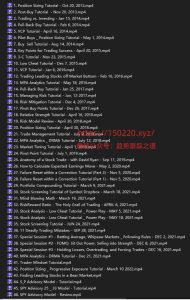![图片[1]-Martin Pring – The Complete Technical Analysis Course-TheTrendFollowing](https://150220.xyz/wp-content/uploads/2024/08/8ff4dcf918162601.jpg)
![图片[2]-Martin Pring – The Complete Technical Analysis Course-TheTrendFollowing](https://150220.xyz/wp-content/uploads/2024/08/d329f30f1c162601.jpg)
Over 7 hours of lessons
Lesson 1 – The Building Blocks of Technical Analysis
Technical Analysis – What it is. Why prices are determined by psychology and how technical analysis can help interpret market psychology.
Trends – What is a trend? How long do they last? How do they integrate?
Arithmetic vs. Logarithmic Scaling – Technical analysis requires charts and the choice of scaling them can be very important. This section explains the difference between these techniques and why one is superior over the other.
Volume – Observations on volume interpretation.
Peak and Trough Analysis – Why it’s probably the most important technical tool. How is it applied in the market place and integrated with other indicators.
Support and Resistance – The concepts defined. Rules for determining where potential support and resistance areas might lie are given along with guidelines for determining their potential significance.
Trendlines – A to Z introductory primmer on trendlines, how to draw and interpret them.
Lesson 2 – Introduction to Classic Price Patterns
This session introduces you to the most common price patterns. Building on the knowledge leaned from the previous DVD, you will be in a better position to understand how patterns are formed and the psychology behind them. If you can rationalize why a pattern is being formed, you will be in a better position to anticipate when a breakout might turn out to be a whipsaw, and how you can protect against this. This session also explains how price objectives are determined from patterns. A large number of market place examples in all time frames is generously dispersed throughout the presentation. The individual formations covered are:
Rectangles
Head and shoulders tops and bottoms
Triangles
Double tops and bottoms and triple formations, including Chinese and Lucky Seven double bottoms.
Broadening formations, broadening wedges and giant wedges
Cup and Handle formations
Lesson 3 – One- and Two-bar Price Patterns
Prices in any freely traded market are determined by psychology. One- and two-bar price patterns represent classic examples of how these emotional characteristics are reflected in the charts.
Patterns covered include:
Outside bars
Inside bars
Two-bar reversals
Exhaustion bars
Key-bar reversals
Pinocchio bars
Three-bar reversals
Lesson 4 – Introduction to Basic Momentum Principles
Key techniques are explained in detail.
They are:
Overbought / oversold
Divergences
Oscillator characteristics in bull and bear markets
Trendlines applied to momentum
Price patterns applied to momentum
Moving averages applied to momentum








![4、[技术教程]回撤买入法视频教程 PullBack Buy Tutorial By Mark Minervini 中英字幕人工校正-TheTrendFollowing](https://150220.xyz/wp-content/uploads/2023/05/07aee2b72d084244-300x211.png)





